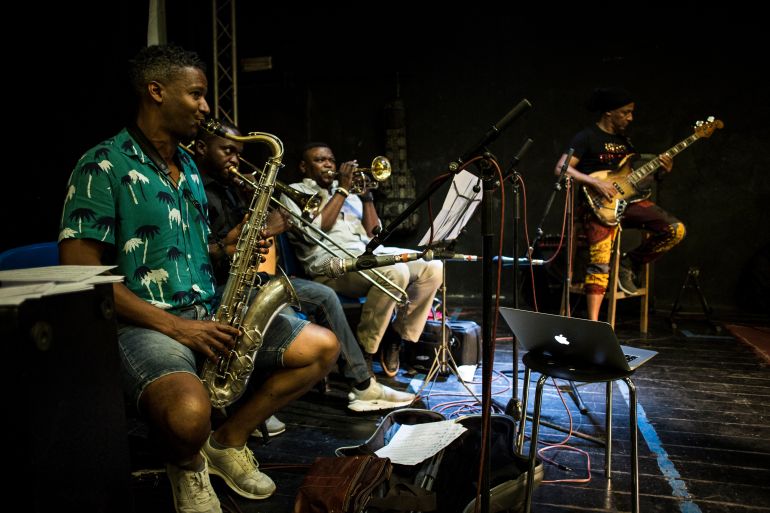‘The soul of the Congolese’: Rumba added to UNESCO heritage list
UN cultural agency adds musical genre and dance to intangible heritage list for its cultural value and power in social cohesion.

UNESCO has added Congolese rumba to its intangible heritage list, sparking enthusiasm among music and dance fans in both the Democratic Republic of the Congo (DRC) and the Republic of the Congo.
The recognition of the musical genre and dance – often referred to as the soundtrack of Congolese history, used for both celebration and mourning – came after a joint application to the United Nations’ cultural agency by the neighbouring countries.
Keep reading
list of 3 itemsAfghan National Music Institute strikes a chord in Qatar
Film, music and representation – Skin and Gurinder Chadha
The rumba “allows the transmission of social and cultural values of the region, but also the promotion of social, intergenerational and united cohesion”, read a statement published by UNESCO on Tuesday.
In a Twitter post, the office of the DRC’s President Felix Tshisekedi expressed “joy and pride” at the inscription of Congolese rumba on the list.
“This cultural gem specific to the two Congos (Kinshasa & Brazzaville) is recognised for its universal value,” it added.
Le Président de la République salue avec joie et fierté l'inscription de la Rumba congolaise sur la liste du patrimoine culturel immatériel de l'humanité par #UNESCO
Ce joyau culturel propre aux deux Congos ( Kinshasa & Brazzaville) est reconnu pour sa valeur universelle. https://t.co/hxZE8nCqgk— Présidence RDC 🇨🇩 (@Presidence_RDC) December 14, 2021
Congolese rumba has now joined the same list as the Cuban rumba, Jamaica’s reggae music and Zaouli – the popular music and dance of the Guro communities in Ivory Coast – among others.
Intangible heritages are traditions or living expressions inherited from ancestors and passed on to descendants. Their importance “is not the cultural manifestation itself, but rather the wealth of knowledge and skills that is transmitted through it from one generation to the next,” according to UNESCO.
“The rumba for Congolese represents their whole life and the history of Congo, as all its biggest historical developments were accompanied by this music,” said Paul Le Perc Ngoie, a percussionist and artist based in the DRC’s capital, Kinshasa.
“There have been various changes, but there is always an inner element that remains and keeps in custody the soul of the Congolese,” Ngoie said.
Common origins
Rumba’s origins can be traced in central Africa, but it was brought across the Atlantic Ocean during the slave trade from the 16th to the 19th century. It was there where slaves from the region, seeking to connect and keep their traditions alive, used to gather among themselves dancing to the NKumba, the word for navel.
“Thanks to this oral tradition, they were able to preserve their history,” said Maika Munan, a celebrated Congolese composer and a rumba expert.
Five Congolese rumba tunes to sing and dance to:
- Marie Louise by Wendo Kolosoy
- African Jazz Mokili Mobimba by Le Grand Kallé
- Adios Tété by Tabu Ley Rochereau
- Mario by Franco Luambo
- Indépendance Cha Cha by Le Grand Kallé
With the passage of time, the NKumba became a major influence on Cuban music, which was introduced in Africa in the late 1930s with the spread of radio and phonograph records – what would later be known as vinyl disc records. Congolese musicians recognised their own beat in the Cuban melodies and began mixing them with their local traditional music, leading to the creation of the modern Congolese rumba.
A new thriving scene had been formed by the early 1940s, with Paul Kamba in Brazzaville, in the Republic of the Congo, founding Victoria Brazza, a pioneer rumba group, while in Kinshasa, musicians such as Wendo Kolosoy and Henri Bowane were among the early heroes.
But it was the following decades that represented “the consecration” of Congolese rumba, said Munan.
As the DRC moved towards independence from Belgian rule in 1960, the music of African Jazz, a popular Congolese rumba band founded by Joseph Kabasele, who was also known as Le Grand Kallé, became an expression of national self awareness.
The band’s epitome came with Indépendance Cha Cha, which was first performed in 1960 in Brussels.
“It was the hymn of Africa,” Munan said of the song, noting that it was a smash hit across the continent commemorating the “Year of Africa” when 17 nations gained independence.
The theme of love is central to rumba music, but it is often used as a metaphor to discuss political and social issues. Today, modern versions of rumba are sung and danced in bars across Congolese cities. And despite each generation making its own version of it, Munan explained, its rhythmic basic pattern – known as clave – remains the same.
“The fact that it is recognised by the world as an intangible cultural heritage, it’s good news, as [the recognition] will enable this music to be maintained, but mostly transmitted to future generations,” he added.